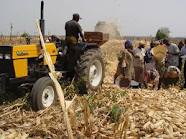The gauge of global food commodity prices declined for the sixth consecutive month in September, with sharp declines in vegetable oil prices more than offsetting higher grain prices, according to a new report released today by the Organization. The FAO Food Price Index averaged 136.3 points in September, down 1.1 percent from August, although it remained 5.5 percent above its value a year earlier. The index tracks monthly changes in international prices for a basket of commonly traded food products. The FAO Vegetable Oil Price Index drove the decline, declining 6.6% over the month to hit its lowest level since February 2021. International quotations for palm, soybean, sunflower and rapeseed oils were all lower. Large persistent palm oil inventories, which coincided with the seasonal increase in production in Southeast Asia, pushed palm oil prices down.
Higher soybean oil export availabilities in Argetina increased supplies of sunflower oil from the Black Sea region, and lower crude oil prices also contributed to the drop in this sub-index. The FAO Cereal Price Index, by contrast, rose 1.5 percent from August. International wheat prices rebounded 2.2%, linked to concerns about dry crop conditions in Argentina and the United States of America, an accelerating pace of exports from the European Union amid high domestic demand and increased uncertainty about the continuation of the Black Sea Grains Initiative beyond November. World corn prices were mostly stable as a strong US dollar offset pressure from a tighter supply outlook linked to declining production prospects in the United States of America and the European Union. The FAO All Rice Price Index rose 2.2 percent, largely in response to changes in India‘s export policy and concerns about the impact of severe flooding in Pakistan. The FAO Dairy Price Index fell 0.6% on the month, largely reflecting the impact of the euro’s weakness against the US dollar, coupled with market uncertainties and gloomy prospects for economic growth. The FAO Meat Price Index decreased by 0.5 percent. World beef prices fell due to high export availabilities from Brazil and high livestock sales in some producing countries, while poultry meat prices fell gradually due to weak demand for import. By contrast, world pork prices increased due to a supply shortfall of ready-to-slaughter animals in the European Union.
The FAO Sugar Price Index fell 0.7 percent in September, mainly related to good production prospects in Brazil coupled with lower ethanol prices and currency movement effects. Lower forecasts for global cereal production, utilisation and trade in 2022/23 FAO today also released the latest Cereal Supply and Demand Report, which further lowered the 2022 global cereal production forecast, now set at 2 768 million tons. Global coarse grain production is forecast at 1 468 million tonnes, down 2.8 percent year-on-year, largely due to poor crop conditions in the United States of America. World rice production is forecast at 512.8 million tonnes, down 2.4 percent from its all-time high reached in 2021, but still an above-average crop.
The downward revision of rice output since September reflects summer dryness and high temperatures in China and floods in Pakistan. The FAO raised its global wheat production forecast in September to 787.2 million tonnes, 1.0 percent higher than a year earlier and on track for a record, due to better-than-expected yields in the European Union. Global cereal utilisation during 2022/23 is now forecast to decline by 0.5 percent from the previous season to 2 784 million tonnes, with the reduction mainly reflecting reduced feed use. World cereal stocks at the end of the 2023 seasons are forecast to contract 1.6% below their opening levels, to 848 million tonnes. The world cereal stocks-to-use ratio is expected to fall to 29.7% in 2022/23 from 31% a year earlier, still relatively high from a historical perspective. World cereal trade is forecast to decline by 2.4% in 2022/23 (July/June) from the previous trading season, with contractions expected in trade for all major cereals. Among other factors, the fallout from the war in Ukraine and the strength of the US dollar are seen as contributing to this decline. 45 countries need external assistance for food 45 countries around the world, including 33 in Africa, nine in Asia, two in Latin America and the Caribbean and one in Europe, need external assistance for food, according to the latest report from Crop Prospects and Report on the Food Situation, a quarterly publication of the FAO Global Information and Early Warning System.
Multi-year droughts have led to severe food insecurity in East Africa, and famines are expected in parts of Somalia unless humanitarian assistance is increased. High inflation rates, challenging macroeconomic environments and depreciating currencies are exacerbating food insecurity conditions in low-income food-deficit countries. The report also forecasts that cereal production in Low-Income Food-Deficit Countries in 2022 will decline by 0.4 percent from 2021.

